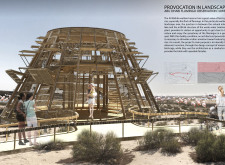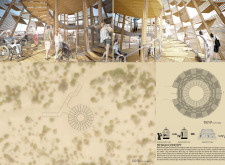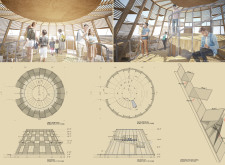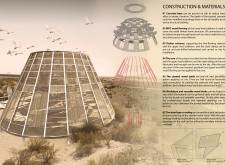5 key facts about this project
The Abu Dhabi Flamingo Observation Tower is located within the Al Wathba wetland reserve, an area known for its rich birdlife, especially flamingos. The design concept takes an interesting approach by reversing the idea of a birdcage. Instead of enclosing birds, the structure invites visitors to step into the habitat, promoting a better connection between people and nature. This immersive experience encourages an appreciation of the local ecosystem.
Design Concept and Layout
The design focuses on changing how visitors interact with wildlife. The observation tower is placed at the intersection of a natural lake and a wastewater treatment plant, highlighting the contrast between natural and man-made environments. Its slanted facades offer spots for birds to rest while providing vantage points for guests. The multi-level layout supports easy movement throughout the space, creating a comfortable flow for those exploring the observation areas.
Materiality and Construction
Selected materials play a crucial role in the tower's function and appearance. A poured concrete base gives it strength and stability, suitable for the specific soil conditions found in the area. The lower platform features wood-plastic composite (WPC) flooring, which is durable and allows for quick assembly. Timber columns support the staircase and upper levels, enhancing the overall structure's reliability. Steel siding wraps sections of the tower, providing weather resistance and a modern look that fits into the natural setting.
Visitor Engagement and Educational Opportunities
The design encourages visitors to engage with the wetland's ecosystem. Lounge areas and well-placed viewing points make it easier for guests to observe the landscape and its wildlife. This thoughtful arrangement allows individuals to learn about local plants and animals, highlighting the importance of conservation. By integrating educational spaces, the structure fosters a deeper understanding of the habitat’s value.
The observation tower's operable facades create a flexible environment for visitors. They offer changing views of the flamingo population while providing perches for birds. The slanted surfaces not only serve practical purposes but also add visual interest. They create an outline against the natural scenery, showing how architecture can work alongside wildlife habitats.






















































